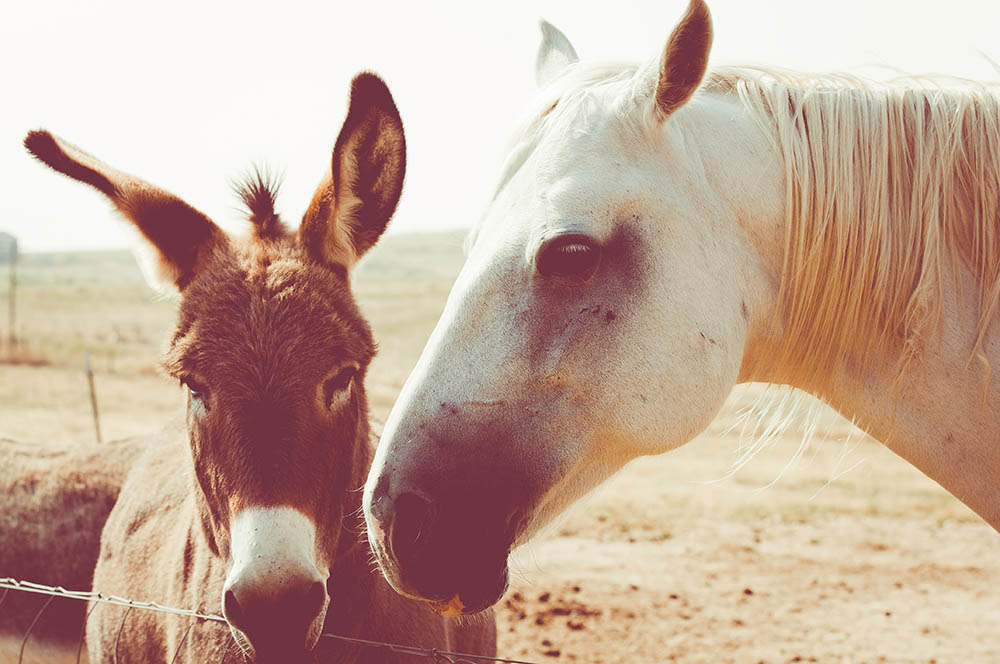Horses, like mules, are domesticated animals that have been serving people for many years. Transportation of things and people is managed successfully by these animals, but the question you might want to ask is: what is the difference between a mule and a horse?
What is a mule?
A mule is a combination of a male donkey and a female horse. Due to this unusual mixture, mules have an odd number of chromosomes (63), so they cannot breed. The infertility of mules means that the good ones cannot pass on their genes.
Female mule individuals are called Mollies, and male mules are known as John. The hybrid of horse and donkey causes many problems in the species, for example, male mules suffer from hormonal imbalance that makes them aggressive and dangerous. It is possible to manage the aggression by neutering the temperamental animal.
Characteristics of mules
- Unique whining – the sounds of a mule are rather compared to a roar, which is heavier, shorter and much more squeaky than the bray of a donkey that we know.
- Long ears – due to the fact that a mule is a mixture of two different species, its ears are much longer than those of horses, but shorter than those of donkeys. Long ears help them survive high temperatures – they provide a large area to dissipate heat in humid and hot climates.
- Mane – mane hair is relatively thin and short and there are long hairs at the ends of the tail.
- Colors – unlike donkeys, mules come in a variety of colors. This is due to the blending of horse genes. You can find mules with the following coats: black, bay, gray, white, dun, roan and sorrel.
- Intelligence – mules usually inherit the best traits from both parents, so they are rideable like horses and smart like donkeys.
- Strong character – mules, like donkeys, can be perceived as stubborn. However, it is not properly understood. If a mule senses danger, it resists going any further, thus signaling the rider to turn back.
- Ability to learn new things – mules have a great memory, which makes teaching them new tricks extremely easy.
Types of mules
There are 3 types of mules:
- Pack mule – the most common type of mule, which is a combination of a donkey and a medium-sized horse, resulting in a perfect, versatile combination. Pack mules are suitable for riding, but are much more frequently used for transport and pulling carts.
- Saddle mule – a special type of mule, intended for riding on steppes, mountains, trails, but also for riding schools, as their nature is extremely calm, which makes these animals perfect for children.
- Draft mule – draft mules are large and massive, which allows them to perform hard work. It is a carefully bred type of mule, and is created by combining a well-selected draft mare with a strong donkey stallion.
Basic differences between a horse and a mule

- Feeding – mules are considerably more hardy than horses, and their bodies are much more resistant to diseases and infections. It is enough for mules to consume medium-quality grass hay or timothy, while horses need hay and grass of the highest quality. Moreover, a working mule needs about 1 kg of concentrate feed, while horses require 2-4 kg of good quality feed.
- Responsiveness – horses are much more delicate to ride and handle than mules, so gentle signals are enough to guide them, while with a mule you need to put in more effort.
- Intelligence – mules tend to be much more intelligent than horses. They learn by observation and are much more deliberate in what they do. Yet still, experts say it is much easier to train a horse than a mule.
- Lifespan – the average life expectancy of a mule is 35-40 years, while for a horse it is 25-30 years.
- Speed – due to their physique and temperament, horses are much faster than mules.
- Body – mules have much smaller nasal passages compared to horses.
- Intuition and defense mechanism – mules have a far better developed defense mechanism and are able to sense and react more quickly to danger.
- Endurance – mules are much stronger and sturdier than horses. A mule can easily carry 30% of its weight, while horses can carry only 20% of theirs.
- Hooves – the mule’s hooves are much harder, which means they can easily handle rough ground.
Differences in the body
- Mules have bigger and longer ears than horses
- Horse legs and hooves are larger than those of a mule
- Mules have shorter tails
- Mules have a thicker coat
- A mule’s chest is wider than horse’s
- Mules have a more stocky and compact body
- Horses are taller than mules
- Mule’s hooves are harder and sturdier
- Mules have rounder eyes and deeper eye sockets
- Mules are more resistant to weather conditions
Is training a mule any different from training a horse?
Yes, it is. Mules require much more attention and patience than horses. Due to their temperament and self-preservation instinct, mules are more reluctant to absorb knowledge and need more time to trust their caretaker. Therefore, training a mule requires calmness and consistency.
Positive reinforcement is crucial when training a mule. Avoid negative reactions and punishment. You should calmly explain the exercise to the mule, and if it fails to do it, repeat the command, avoiding negative emotions or change of attitude.
Conclusion
Horses are extremely intelligent creatures, eager to help and work with humans. Mules inherit some of the best qualities of horses and form a species that is equally useful and intelligent.

